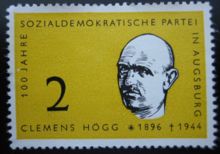Clemens Högg
Clemens Högg (born November 20, 1880 in Wurzach , † March 11, 1945 in Bergen-Belsen ) was a Bavarian member of the state parliament and founder of the workers' welfare in Neu-Ulm and Augsburg . He died in a concentration camp shortly before the end of the Second World War .
Life
After finishing school, Högg learned the blacksmith's trade. He joined the social democratic movement in the empire and was active. Högg founded the SPD local association, then called "Section", in Neu-Ulm. In 1919 and 1920 he held the office of mayor there. During the First World War , the journeyman was forced to join the Maschinenfabrik Augsburg-Nürnberg AG ( MAN ) in Augsburg . In this city, too, he was active in political work from 1919 and one year later was deputy chairman of the Augsburg SPD and a full-time party functionary for the Swabian district . The oratorically gifted and convincing Högg was sent to the Bavarian state parliament in 1924 by voters in the constituencies of Augsburg II and Illertissen . Only after the National Socialists came to power did he, like all other members of the SPD parliamentary group, lose his mandate.
In 1922, on Högg's initiative, the local branches of the young workers' welfare organization in Neu-Ulm and Augsburg were established. Two years later he was elected chairman of the Augsburg charity. In 1927 he created the Swabian District Association.
From the beginning, the bustling Social Democrat was a thorn in the side of the Augsburg National Socialists. After an unsuccessful attempt at murder by SS men in his apartment, he was arrested in early March 1933 and held in the Augsburg Gestapo prison until June. From August 1933 to October 1934 Högg was a prisoner of political dissent in the Dachau concentration camp .

In September 1939, the former member of the state parliament was arrested again. This time he was sent to the Sachsenhausen concentration camp in Oranienburg . The commandant was Hans Loritz from Augsburg. Högg spent 28 months in solitary confinement on his orders. The conditions of detention led to his blindness, and one leg had to be amputated. The concentration camp inmates were brought to the Bergen-Belsen concentration camp in March 1945 before the advancing Red Army . Clemens Högg died there, further details of the death are not known.
Honors
- The Clemens-Högg-Haus, a home for the mentally disabled of the Augsburg workers' welfare organization, keeps his name in memory.
- A stumbling block by the artist Gunter Demnig lies in the floor in front of Högg's former home at Metzstraße 37, Augsburg . A memorial plaque is attached to the facade of this house, in which Högg lived from 1927 to 1939.
- In March 2018, a memorial stone for Högg was erected on the site of the former Bergen-Belsen concentration camp .
- In Augsburg-Pfersee and in Pfuhl (Neu-Ulm) streets are named after Clemens Högg.
literature
- Heinz Münzenrieder: On the 50th anniversary of Clemens Högg's death. Augsburg 1995.
- Heinz Münzenrieder: Clemens Högg 1880–1945. Social democratic resistance fighter. In: Wolfgang Haberl (ed.): Pictures of life from Bavarian Swabia . Weissenhorn 2004.
- Dirk Riedel: Vigilante and mass murderer in the service of the "Volksgemeinschaft": The concentration camp commandant Hans Loritz . Metropol Verlag, Berlin 2010, ISBN 978-3-940938-63-3 . Page 244ff.
Web links
- Brief CV of Clemens Högg gedenkstaettenpaedagogik-bayern.de
- Clemens Högg House AWO Augsburg
- Portrait VVN Augsburg
Individual evidence
- ↑ http://www.awo-schwaben.de/aktuell/awo-aktuell/359-stolperstein-fuer-clemens-hoegg.html
- ↑ https://www.stadtzeitung.de/augsburg-city/lokales/spaete-erinnerung-an-awo-gruender-clemens-hoegg-d14806.html
- ↑ dpa-infocom GmbH: Memorial for SPD politician Högg in Bergen-Belsen. In: welt.de . March 12, 2018, accessed October 7, 2018 .
| personal data | |
|---|---|
| SURNAME | Högg, Clemens |
| BRIEF DESCRIPTION | Bavarian Member of Parliament (SPD) |
| DATE OF BIRTH | November 20, 1880 |
| PLACE OF BIRTH | Wurzach |
| DATE OF DEATH | March 11, 1945 |
| Place of death | Bergen-Belsen |
